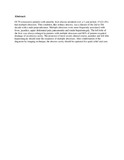| dc.contributor.author | Sharma, MP | |
| dc.contributor.author | Acharya, KS | |
| dc.contributor.author | Verma, N | |
| dc.contributor.author | Dasarathy, S | |
| dc.date.accessioned | 2013-07-05T07:12:09Z | |
| dc.date.available | 2013-07-05T07:12:09Z | |
| dc.date.issued | 1990 | |
| dc.identifier.citation | KIRTDA, DRACHARYAS. 1990. Sharma MP, Acharya SK, Verma N, Dasarathy S.Clinical profile of multiple amoebic liver abscesses.J Assoc Physicians India. 1990 Nov;38(11):837-9.. | en |
| dc.identifier.uri | http://profiles.uonbi.ac.ke/sacharya/publications/sharma-mp-acharya-sk-verma-n-dasarathy-sclinical-profile-multiple-amoebic-live | |
| dc.identifier.uri | http://erepository.uonbi.ac.ke:8080/xmlui/handle/123456789/45636 | |
| dc.description.abstract | Of 70 consecutive patients with amoebic liver abscess admitted over a 3 year period, 15 (21.4%) had multiple abscesses. This condition, like solitary abscess, was a disease of the 2nd to 5th decade with a male preponderance. Multiple abscesses were more frequently associated with fever, jaundice, upper abdominal pain, pneumonitis and tender hepatomegaly. The left lobe of the liver was always enlarged in patients with multiple abscesses and 86% of patients required drainage of an abscess cavity. The presence of more severe clinical course, jaundice and left lobe hepatomegaly should raise the suspicion of multiple abscesses. After confirmation of the diagnosis by imaging technique, the abscess cavity should be aspirated for quick relief and cure. | en |
| dc.language.iso | en | en |
| dc.title | Clinical profile of multiple amoebic liver abscesses | en |
| dc.type | Article | en |
| local.publisher | Department of Medicine, College of Health Sciences, University of Nairobi | en |

